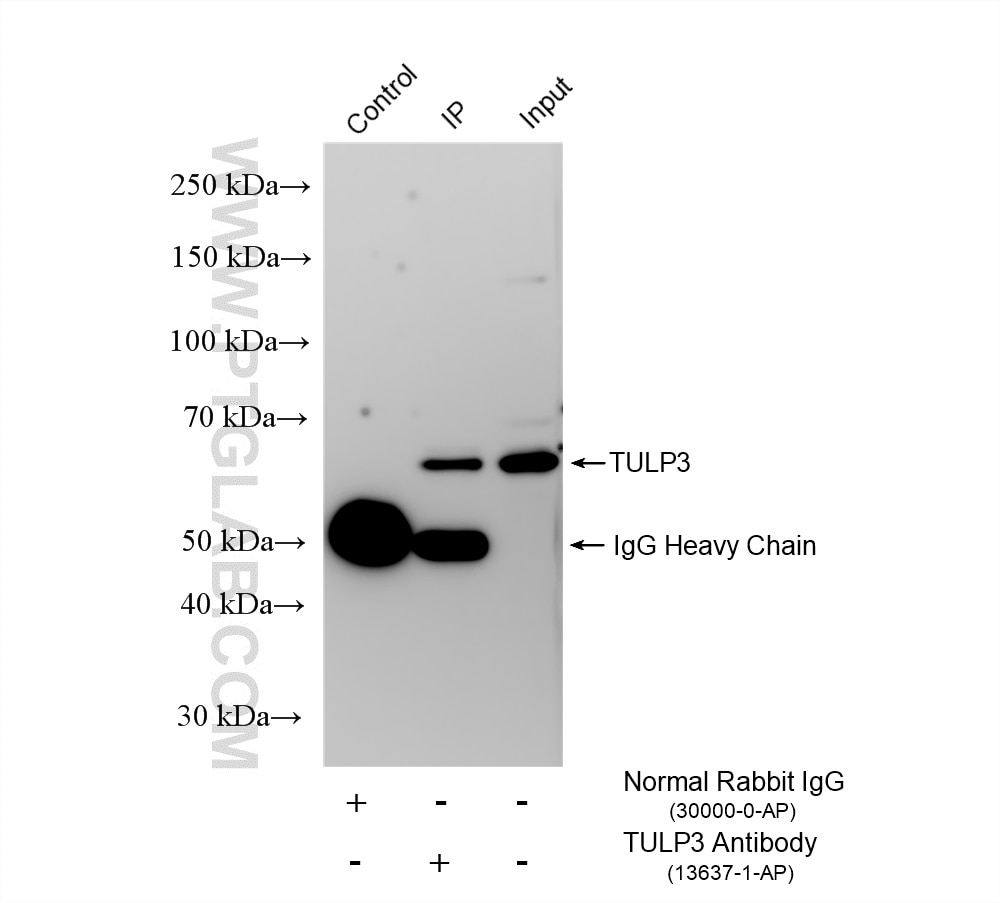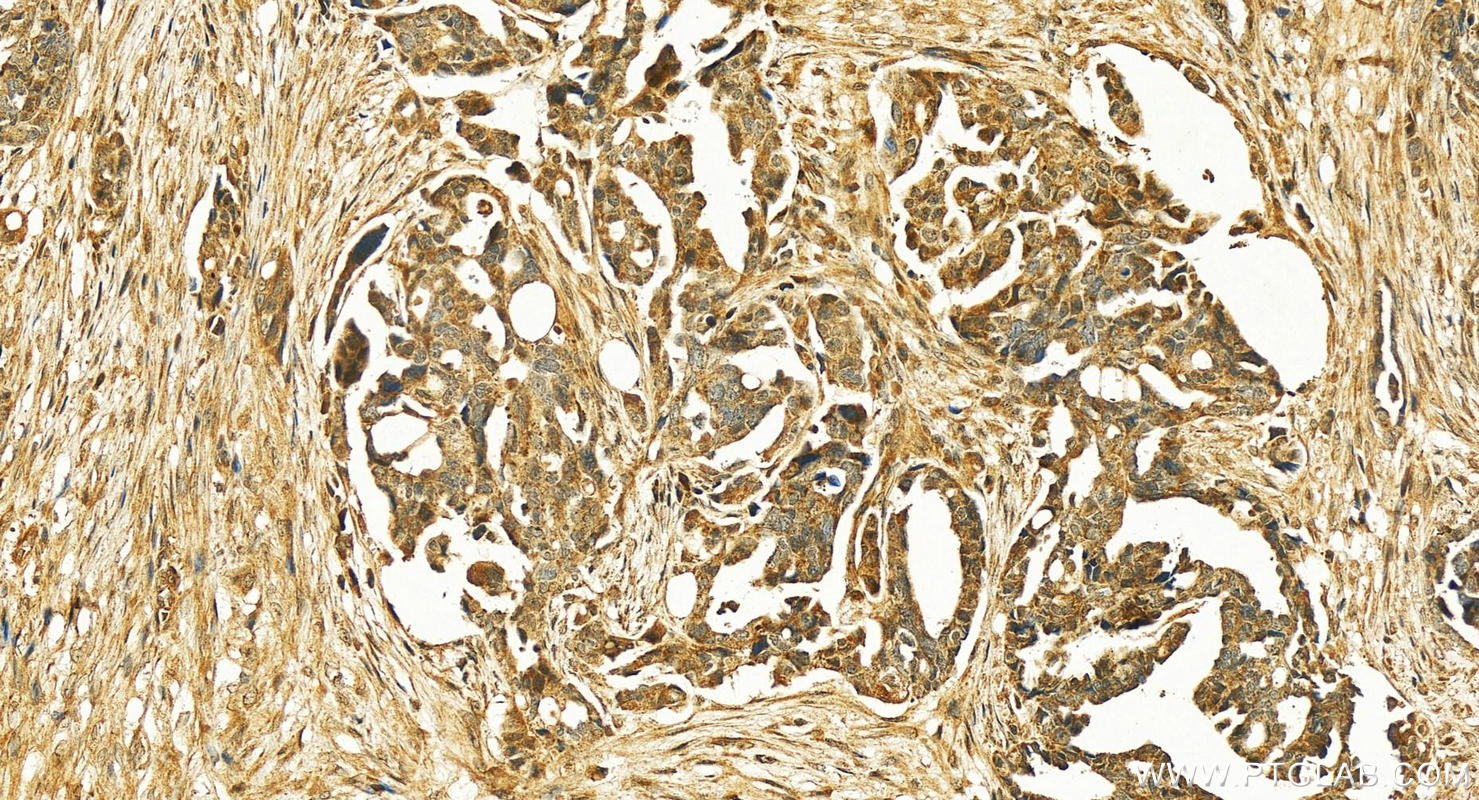Validation Data Gallery
Tested Applications
| Positive WB detected in | HEK-293 cells, SH-SY5Y cells, HeLa cells, SK-N-SH cells |
| Positive IP detected in | SH-SY5Y cells |
| Positive IHC detected in | human ovary cancer tissue, human gliomas tissue Note: suggested antigen retrieval with TE buffer pH 9.0; (*) Alternatively, antigen retrieval may be performed with citrate buffer pH 6.0 |
Recommended dilution
| Application | Dilution |
|---|---|
| Western Blot (WB) | WB : 1:1000-1:8000 |
| Immunoprecipitation (IP) | IP : 0.5-4.0 ug for 1.0-3.0 mg of total protein lysate |
| Immunohistochemistry (IHC) | IHC : 1:50-1:500 |
| It is recommended that this reagent should be titrated in each testing system to obtain optimal results. | |
| Sample-dependent, Check data in validation data gallery. | |
Published Applications
| KD/KO | See 4 publications below |
| WB | See 9 publications below |
| IHC | See 1 publications below |
| IF | See 9 publications below |
| CoIP | See 1 publications below |
Product Information
13637-1-AP targets TULP3 in WB, IHC, IF, IP, CoIP, ELISA applications and shows reactivity with human, mouse, rat samples.
| Tested Reactivity | human, mouse, rat |
| Cited Reactivity | human, mouse |
| Host / Isotype | Rabbit / IgG |
| Class | Polyclonal |
| Type | Antibody |
| Immunogen |
CatNo: Ag4570 Product name: Recombinant human TULP3 protein Source: e coli.-derived, PGEX-4T Tag: GST Domain: 96-442 aa of BC032587 Sequence: DEVHAPSVSSSVVEEDAENTVDTASKPGLQERLQKHDISESVNFDEETDGISQSACLERPNSASSQNSTDTGTSGSATAAQPADNLLGDIDYLEDFVYSPAPQGVTVRCRIIRDKRGMDRGLFPTYYMYLEKEENQKIFLLAARKRKKSKTANYLISIDPVDLSREGESYVGKLRSNLMGTKFTVYDRGICPMKGRGLVGAAHTRQELAAISYETNVLGFKGPRKMSVIIPGMTLNHKQIPYQPQNNHDSLLSRWQNRTMENLVELHNKAPVWNSDTQSYVLNFRGRVTQASVKNFQIVHKNDPDYIVMQFGRVADDVFTLDYNYPLCAVQAFGIGLSSFDSKLACE 相同性解析による交差性が予測される生物種 |
| Full Name | tubby like protein 3 |
| Calculated molecular weight | 442 aa, 50 kDa |
| Observed molecular weight | 60 kDa |
| GenBank accession number | BC032587 |
| Gene Symbol | TULP3 |
| Gene ID (NCBI) | 7289 |
| RRID | AB_2211547 |
| Conjugate | Unconjugated |
| Form | |
| Form | Liquid |
| Purification Method | Antigen affinity purification |
| UNIPROT ID | O75386 |
| Storage Buffer | PBS with 0.02% sodium azide and 50% glycerol{{ptg:BufferTemp}}7.3 |
| Storage Conditions | Store at -20°C. Stable for one year after shipment. Aliquoting is unnecessary for -20oC storage. |
Background Information
The tubby-like protein 3 (TULP3) has been identified as a member of tubby and tubby-like proteins (TULPs) that plays an important role in maintenance and function of neuronal cells during development and post-differentiation. Tulp3 gene is essential for embryonic development in mice. Recently TULP3 has been reported to bind to the IFT (intraflagellar transport)-A complex and promote trafficking of G protein-coupled receptors into primary cilia, which is implicated in regulating neuronal function.
Protocols
| Product Specific Protocols | |
|---|---|
| IHC protocol for TULP3 antibody 13637-1-AP | Download protocol |
| IP protocol for TULP3 antibody 13637-1-AP | Download protocol |
| WB protocol for TULP3 antibody 13637-1-AP | Download protocol |
| Standard Protocols | |
|---|---|
| Click here to view our Standard Protocols |
Publications
| Species | Application | Title |
|---|---|---|
Sci Adv Ciliopathy protein HYLS1 coordinates the biogenesis and signaling of primary cilia by activating the ciliary lipid kinase PIPKIγ. | ||
PLoS Genet Zfp423 Regulates Sonic Hedgehog Signaling via Primary Cilium Function.
| ||
J Neurosci Comparison of ciliary targeting of two rhodopsin-like GPCRs: role of C-terminal localization sequences in relation to cilium type.
| ||
J Biol Chem Deletion of the phosphatase INPP5E in the murine retina impairs photoreceptor axoneme formation and prevents disc morphogenesis. |






